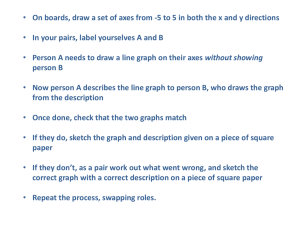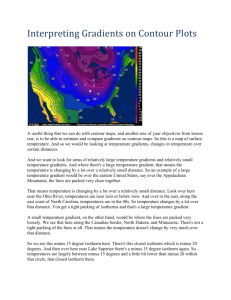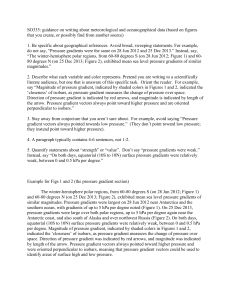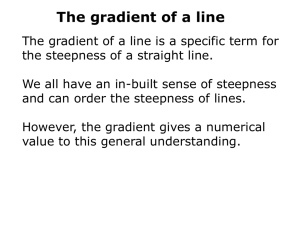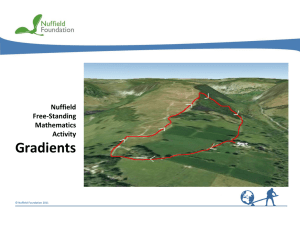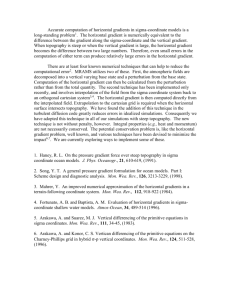the calculation / worked solution and further background on graphs.
advertisement
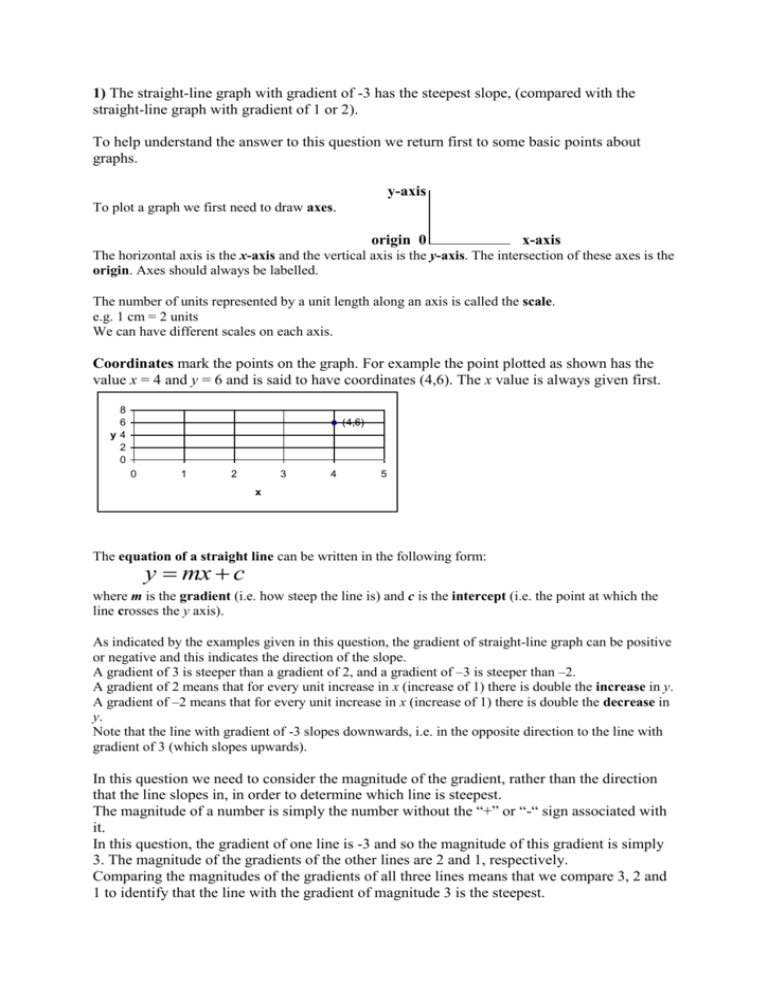
1) The straight-line graph with gradient of -3 has the steepest slope, (compared with the straight-line graph with gradient of 1 or 2). To help understand the answer to this question we return first to some basic points about graphs. y-axis To plot a graph we first need to draw axes. origin 0 x-axis The horizontal axis is the x-axis and the vertical axis is the y-axis. The intersection of these axes is the origin. Axes should always be labelled. The number of units represented by a unit length along an axis is called the scale. e.g. 1 cm = 2 units We can have different scales on each axis. Coordinates mark the points on the graph. For example the point plotted as shown has the value x = 4 and y = 6 and is said to have coordinates (4,6). The x value is always given first. 8 6 y4 2 0 (4,6) 0 1 2 3 4 5 x The equation of a straight line can be written in the following form: y mx c where m is the gradient (i.e. how steep the line is) and c is the intercept (i.e. the point at which the line crosses the y axis). As indicated by the examples given in this question, the gradient of straight-line graph can be positive or negative and this indicates the direction of the slope. A gradient of 3 is steeper than a gradient of 2, and a gradient of –3 is steeper than –2. A gradient of 2 means that for every unit increase in x (increase of 1) there is double the increase in y. A gradient of –2 means that for every unit increase in x (increase of 1) there is double the decrease in y. Note that the line with gradient of -3 slopes downwards, i.e. in the opposite direction to the line with gradient of 3 (which slopes upwards). In this question we need to consider the magnitude of the gradient, rather than the direction that the line slopes in, in order to determine which line is steepest. The magnitude of a number is simply the number without the “+” or “-“ sign associated with it. In this question, the gradient of one line is -3 and so the magnitude of this gradient is simply 3. The magnitude of the gradients of the other lines are 2 and 1, respectively. Comparing the magnitudes of the gradients of all three lines means that we compare 3, 2 and 1 to identify that the line with the gradient of magnitude 3 is the steepest. This means that the straight-line graph with gradient of -3 has the steepest slope, (compared with the straight-line graph with gradient of 1 or 2), although this line slopes downwards whereas the other two slope upwards. Examples of lines with gradients of 2, 1 and -3, respectively, are provided below. The following linear equations can be plotted as straight-line graphs with gradients of 2 (m = 2): y 2x y 2x 5 y 2x 1 The following linear equations can be plotted as straight-line graphs with gradients of 1 (m = 1): yx y x5 y x 1 The following linear equations can be plotted as straight-line graphs with gradients of -3 (m = -3): y 3 x y 5 3x y 3 x 1 The following equations (selected from those above) all have the same intercept of 5 (c = 5): y 2x 5 y x5 y 5 3x The following equations (selected from those above) all have the same intercept of -1 (c = -1): y 2x 1 y x 1 y 3 x 1 For extra practice you might like to try to plot these graphs on graph paper or other squared paper so you can see for yourself where these lines cross the y-axis to check the intercept value (when x=0) and compare gradients. Hint: To draw a graph of y = 2x + 5 for values of x between –3 and 3, consider completing the following table to help you work through the different steps. x -3 -2 -1 0 1 2 3 2x -6 -4 -2 0 2 4 6 +5 +5 +5 +5 +5 +5 +5 +5 y -1 1 3 5 7 9 11 From this table you can read off coordinates (x, y) from the top and bottom rows, to plot on your paper, and then join up the dots or crosses with a straight line: (-3,-1) (-2,1) (-1,3) (0,5) (1,7) (2,9) (3,11)
